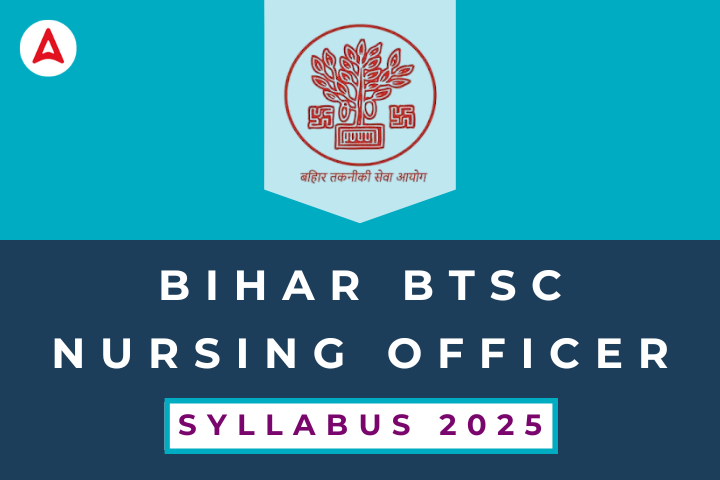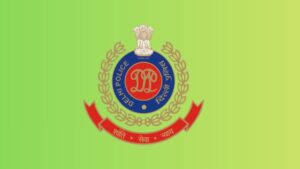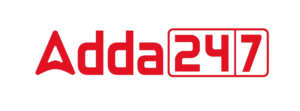With the announcement of 498 vacancies under the Bihar BTSC Nursing Tutor Recruitment 2025, aspiring candidates must have a clear understanding of the syllabus. Knowing the detailed Bihar BTSC Nursing Tutor Syllabus 2025 helps in planning a focused and effective preparation strategy. It ensures that candidates cover all the important topics likely to be asked in the exam and boosts their chances of performing well in the exam. The detailed BTSC Nursing Tutor Syllabus 2025 has been provided in this article.
Bihar BTSC Nursing Tutor Syllabus 2025
With the release of the short notice, it has become important for candidates to begin their preparation without delay. Going through the Bihar BTSC Nursing Tutor Syllabus 2025 at this stage will help in building a strong foundation and managing time effectively. Early preparation based on the syllabus allows candidates to cover all topics thoroughly and boosts confidence ahead of the BTSC Nursing Tutor exam.
Bihar BTSC Nursing Tutor Syllabus 2025: Nursing Foundations
a). Hospital Admission and Discharge: Admission to the hospital: Unit and its preparation admission bed. Admission procedure, Special considerations, Medico legal issues in admission, Roles and responsibilities of the nurse in admission. Discharge from the hospital: Types of discharge: Planned discharge, LAMA/DAMA and abscond, referrals and transfers. Discharge planning. Discharge procedure. Special considerations. Medico legal issues in discharge, Roles and responsibilities of the nurse in discharge. Care of the unit after discharge.
b). Communication and Nurse Patient Relationship: Communication and nursing practice; Basic elements of communication process, Forms of communication, Professional nursing relationship, Elements of professional, communication, Patient teaching: importance, purpose, process, role of nurse.
c). Documentation and Reporting: Documentation: Purpose of recording and reporting Communication within the health care team Types of records: ward records, medical/nursing records, Common record keeping forms, computerized documentation; Guideline for reporting: factual, basis, accuracy, completeness, correctness, organization, & confidentiality: Methods of recording; Reporting: Change of shift, reports, Transfer reports, incident reports.
d). Vital Signs: Guidelines for taking vital signs.
- Body temperature: Physiology, regulation, factors, affecting body temperature. Assessment of body temperature: sites, equipment’s and technique, special considerations, Temperature alterations (hyperthermia, hypothermia & Heatstroke): assessment & management, Hot and cold applications.
- Pulse: Physiology and regulation, characteristics of the pulse, factors affecting pulse. Assessment of pulse: sites, location, equipment’s and technique, special considerations. Alterations in pulse: Tachycardia and bradycardia.
- Respiration: Physiology and regulation, mechanics of breathing, characteristics of the respiration, factors affecting respiration. Assessment of respiration: techniques, special consideration. Alteration in respiration: types, assessment & management.
- Blood pressure: Physiology and regulation, characteristics of the blood pressure, factors affecting blood pressure Assessment of blood pressure sites equipment’s and technique, special considerations Alterations in blood pressure: Hypertension and hypotension.
e). Care of Equipment and Linen: Indent, maintenance and inventory; Disposable; Reusable; Rubber goods; Enamelware; Stainless steel articles; Glassware; Hospital furniture; Sharp instruments; Machinery.
f). Care in Special Condition: Unconscious patient; Patient with fluid imbalance; Patient with Dyspnea; physically handicapped; Perineal care of terminally ill-patient with urinary catheter.
g). Infection Control in Clinical Settings: Nature of Infection; Chain of infection transmission; Hospital acquired infection; Hand washing: Medical and surgical hand washing; Disinfection of equipment and unit.
h). Barrier Nursing: Standard Safety precaution (Universal Precaution); Different types of hand washing; Personal protecting equipment’s types, uses, techniques of wearing and removing.
m). Biomedical waste management: Concept and importance; Segregation of hospital waste; Treatment, transportation and disposal of hospital waste.
n). Administration of drugs: Purposes of drugs; Routes of administration; Principles: Rights, special consideration, prescription, safety in administering drugs; Storage and maintenance of drugs and nurses responsibility; Factors influencing drugs action; Terminologies and common abbreviation used in prescription of drugs.
o). First Aid: Meaning of First Aid; Rules of First Aid. First Aid in emergency Situation suchas:- Fire, Earthquakes, Famines; Fractures; Accidents; Poisoning; Drowning; Hemorrhage; Insects bites; Foreign bodies; Transportation of the injured Bandaging and splinting; Immediate and later role of nurses
p). The dying Patient: Signs and symptoms of approaching death; Needs of the dying patient and relatives; Care of dying and last offices; Packing of dead bodies in non-communicable and communicable diseases
q). Meeting Needs of Hospitalized Patient:
- Patient safety: Environmental safety: temperature, humidity, noise, ventilation, light, odour, pests control; Fall, fire and accident safety; Safety devices: restraints, side rails, airways, trapez etc.
- Hygiene: Hygienic care: Hair care, Oral care, Bed bath, Back care, Hand-feet & nail care, Eye care, Care of ear and nose; Patient environment: Unit cleaning/ disinfection
- Comfort: Types of bed sand bed Making; Comfort devices; Pain management: Nature, types, factors influencing pain, coping, assessment and management of pain.
- Elimination needs: Problems in sickness: Constipation, diarrhea, retention and incontinence of urine; Nurses role in meeting eliminating needs.
- Meeting nutritional needs: Importance of Nutrition; Factors effecting nutritional needs.
- Activity and Exercises: Importance of activity and Exercise in healthand sickness, active and passive Exercise.
Bihar BTSC Nursing Tutor Syllabus 2025: Medical Surgical Nursing (Including Pathophysiology & Pharmacology)
a) Role and responsibilities of a nurse in Medical and Surgical Settings: Out Patient Units; In Patient Units; Intensive Care Units; Home and Community setting
b) Care of Surgical patient: Pre-operative; Intra operative; Post-operative; Nurses functions in operation theatre
c) Anesthesia: Classification, anesthetic agents and role of a nurse in anesthesia.
d) Disorders of the Respiratory System: Etiology, Clinical manifestation, diagnosis, treatment and medical, surgical, dietetics and Nursing Management with: Asthma, Pneumonia, Lung abscess, Pleurisy, Emphysema, Bronchiectasis, Pulmonary Tumours, Pleural Effusions, Pulmonary Tuberculosis, Acute Respiratory distress syndrome, Preventive and rehabilitative
aspects.
e) Cardiovascular System: Diseases of heart; Cardiac arrhythmias; Cardiac arrests; Heart Blocks; Pericarditis, Myocarditis, Endocarditis; Congestive heart failure; Hypertension; Angina Pectoris; Valvular Diseases, Basic life support, Advance cardiac life support.
f) Vascular Diseases: Arteriosclerosis; Atherosclerosis; Varicose veins and aneurysms.
g) Blood Disorder: Anaemia; Leukemia; Haemophilia; Hodgkins Diseases Blood Transfusion: Indications; Grouping and matching; R.H factors; Plasma precautions in administration; Blood bank functioning and hospital transfusion committee. Bio-safety and waste management in relation to blood transfusion
h) Gastro Intestinal System: Stomatitis, gingivitis and parotitis; Dentalcaries; Tumours; Gastritis; Peptic ulcer; Enteritis; Colitis; Appendicitis; Haemorrhoids; Hernia; Hepatitis; Cirrhosisof liver; Liverabscess; Cholecystitis; Hepaticcoma; Pancreatitis; Carcinoma of liver and Pancreas; Tuberculosis
i) Musculo-Skeletal System: Disorder and diseases of bones and joints: Sprains, Dislocation, Fractures, Arthritis, Osteomyelitis, Tumours, Tuberculosis, Deformities
j) Genito Urinary System: Diseases of kidney, ureter, bladder and urethra; Congenital abnormalities; Acute and chronic nephritis; Nephrosis; Uraemia; Tumours; Tuberculosis; Obstruction; Pyelitis and Pyelonephritis; Cystitis; Disorder of Micturition; Urethritis; Cancer Penis; Inflammation of testes, Epididymis and Prostate glands; Prostatic hypertrophy; Malignancy. Dialysis, renal transplant, trauma of ureter, bladder, urethra.
k) Nervous System: Diseases of Brain: Headache, Migraine; Epilepsy; Tumours; Chorea; Parkinsonism; Meningitis; Encephalitis; head and spinal cord Injuries; Cerebro-vascular accidents, haemorrhage, Embolism and thrombosis Diseases of Spinal Cord : Myelitis; Injuries; Tumours; Spinal cord compressions Diseases of Nerves: Neuritis and neuralgia; Myasthenia-gravis; Sciatica; Heat Stroke, heat Exhaustion; Cranial, Spinal Neuropathies
l) Endocrine System, Metabolic disorders, deficiency diseases: Hyper and hypo Secretions of: Thyroid, Parathyroid, Pituitary, Adrenal gland; Cysts/Tumours; Metabolic Disorders: Diabetes Mellitus; Obesity; Gout; Deficiency Diseases: Common deficiency diseases; Prevalence in India; Early symptoms, prevention and treatment.
m) Operation Theatre: General set up of operation theatre and team; Theatre technique: – hand washing, gowning and gloving; Preparation of theatre equipment and instruments in common use; Role of a nurse in care of patient in the theatre; Principle of recovery room’s care.
n) Intensive Care Nursing: Concept; Principles of Intensive Care Nursing; Role of a nurse in I.C.U; Common gad gets use in I.C.U/C.C.U-Cardiac Monitors, Birds, respirator, defibrillators, etc
o) Diseases and Disorders of eye: Blindness-causes and prevention; Eye banking, Community services; Conjunctivitis; Glaucoma; Cataract; Retinal detachments; Eye prostheses and rehabilitation; Injury and hemorrhage
p) Diseases of the ear: Wax; Foreign bodies; Furunculosis; Fungal infections; Otitis Media; Injuries and deafness; Mastoiditis; Menieres syndrome Disease of nose and throat: Rhinitis; Defected Septum; Sinusitis; Allergy; Adenoids; Laryngitis; Tonsillitis; Pharyngitis; Injury
q) Communicable Diseases: Virus: Measles, influenza. Chickenpox, Smallpox, Mumps, infective hepatitis, poliomyelitis Bacteria: Diphtheria, Whooping cough, tetanus, leprosy, typhoid, dysentery, gastro-enterities and cholera Zoonoses: Kala-azar, plague, replapsing fever and rabies; Mosquito: Malaria, filaria, dengue fever Sexually transmitted diseases: Gonorrhoea, Syphilis, Chancroid
r) Nursing management of patient with Immunological problems: Review of Immune system; Immunodeficiency disorders -HIV and AIDS.
s) Nursing Management Of Patients With oncological conditions: Structure & characteristics of normal & cancer cells; Prevention, screening, early detection, Common malignancies of various body systems warning signs of cancer; Modalities of treatment; Hospice care Stomal therapy.
t) Nursing management of patient in disaster situations: Causes and types of disaster; Policies related to emergency / disaster management at international, national, state, institutional level; Disaster Management.
Bihar BTSC Nursing Tutor Syllabus 2025: Midwifery and Gynaecological Nursing
a) Normal Pregnancy: Physiological changes due to pregnancy; Signs, symptoms and diagnosis; Influence of hormones
b) Pre-natal care: Objectives; History taking; Calculation of Expected date of delivery; Routine Examinations
c) Diseases associated with pregnancy: Cardio vascular; Urinary; Respiratory; Metabolic; Nutritional deficiencies; Sexually transmitted diseases
d) Normal Delivery (Preparation): For mother and baby; Preparation of the patient and delivery room-hospital and home; Psychological preparation of mother and family.
e) Normallabour: Definition, stage and duration; Causes of onset of labour; True and False labour
f) First stage of labour: Signs of onset of labour; Physiological changes in first stage of labour; Management preparation of labour; Preparation of women in labour-Physical and Psychological; Equipments for normal delivery; Monitoring of maternal and foetal condition; Vaginal Examination
g) Second Stage of labour: Signs of second stage; Mechanisms of labour; Monitoring of maternal and foetal conditions; Procedure for conduct of normal delivery; Prevention of Perineal tear; Episiotomy, suturing and care
h) Third Stage of labour: Signs, Physiological changes; Immediate care of baby; Technique of placenta expulsion and examination of placenta; Monitoring of maternal and newborn baby Nursing Management of Baby and birth: Assessment; Apgar scoring, examination for defects (head to foot examination); Care of cord, eyes and skin; Maintenance of body temperature; Prevention of infection and injury.
i) Nursing Management of mother during puerperium: Definition, objectives of care; Immediate postnatal care; Physiological changes during puerperium; Care of Episiotomy; Establishment of breast feeding; Postnatal Exercises; Postnatal Examination, follow up family welfare; Minor ailments and management
j) Complications of pregnancy and its management: Bleeding in early pregnancy; Bleeding in late pregnancy; Pregnancy induced hypertension, Pre-Eclampsia, Eclampsia; Hydramnios, Oligohydramnios; Hydatidiform mole; Pelvic inflammatory disease; Intra uterine growth retardation, intra uterine death; Post maturity
k) High risk pregnancy and its management: Anaemia, Jaundice, Viral infection; Urinary tract infections; Heart diseases, diabetes mellitus; Osteomalacia; Sexually Transmitted diseases; AIDS; Teenage Pregnancy; Elderly pregnancy; Multi Para & Multiple pregnancy; UnEducated mother
l) Labour Complications: Malpresentations and malpositions; Occipito posterior position; Breach and shoulder; Face and Brow; Cord presentation and prolapse; Obstructed labour; Ruptured uterus; Post partum haemorrhage, atonicuterus, retained placenta and membranes
m) Complications of puerperium and its management: Puerperal pyrexia, puerperal sepsis, Thrombophlebitis, Embolism, puerperal Psychosis
n) Obstetrics operations: Manual removal of placenta; Version: Internal, External; Vacuum extraction; Caesarean section; Medical termination of pregnancy; Laparoscopic sterilization; Embryotomy
o) Fertility and Infertility: Definition, causes both in male and female investigation and management
p) Diseases and disorders of female reproductive system including breasts: Infections; cyst, tumors and fibroids; Abortion; Ectopic pregnancy; Vaginal fistula; Erosion of cervix; Sexually transmission disease; Abnormalities of menstruation; Menopause; Mastitis; Breast abscess; Tumours; Malignancy
Bihar BTSC Nursing Tutor Syllabus 2025: Child Health Nursing
a) The healthy child: Growth and developments and factors affecting growth and development; Assessment of growth and development; Nurses responsibility to meet the nutritional needs; Childhood Accidents; Play – importance & therapeutic use; Review of immunization schedule;, child guidance clinics
b) Care of Newborn: Appraisal of Newborn; Nursing care of a normal new born / essential new born care; Neonatal resuscitation; Kangaroo mother care, Nursing management of common
neonatal disorder: low birth weight baby; Hyperbilirubinemia; Hypothermia hyperthermia; Metabolic disorder; Neonatal infections; Neonatal seizures; Respiratory distress syndrome; Organization of neonatal care unit.
c) Recognition and Management of Congenital anomalies: Causes, Prevention management; Preparation of the parents; Parents counselling.
d) Breast Feeding: Importance and principles; Preparation of mother; Difficulties in breast feeding; Factors in habiting and promoting lactation
e) Diseases of Children: Etiology, Signs and symptoms, medical and surgical management, nursing care, Complication, diet and drug therapy, prevention and treatment with diseases
Bihar BTSC Nursing Tutor Syllabus 2025: Mental Health Nursing
a). Role of the Nurse: Over active patient; Destructive patient; Suicidal patient; Depression; Withdrawal and Mania; Prevention of accidents amongst mentally ill; Observation reporting and recording; Procedure for admission into and discharge from mental hospitals.
Download Bihar BTSC Nursing Tutor Syllabus PDF
The Bihar BTSC will soon be conducting the Bihar BTSC Nursing Tutor exam at the end of August 2025 or the beginning of September 2025, which creates a big sense of urgency for nursing aspirants who, alongside carrying a passion in the teaching domain, to start their preparations. And though we have provided the detailed syllabus above, aspirants must have a downloaded PDF format of the syllabus so that they can prepare without the need to be online. So, here is the direct link to download the Bihar BTSC Nursing Tutor Syllabus PDF.




 Delhi Police Constable Driver Syllabus 2...
Delhi Police Constable Driver Syllabus 2...
 Punjab PCS Syllabus 2026 and Exam Patter...
Punjab PCS Syllabus 2026 and Exam Patter...
 Haryana HSSC Stenographer Syllabus 2026,...
Haryana HSSC Stenographer Syllabus 2026,...

 Adda247 Job portal has complete information about all Sarkari Jobs and Naukri Alerts, its latest recruitment notifications, from all state and national level jobs and their updates.
Adda247 Job portal has complete information about all Sarkari Jobs and Naukri Alerts, its latest recruitment notifications, from all state and national level jobs and their updates.



